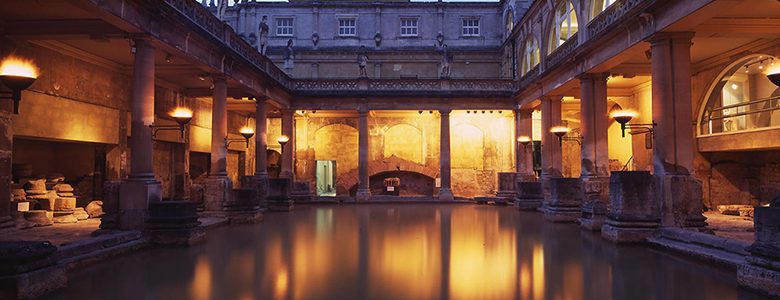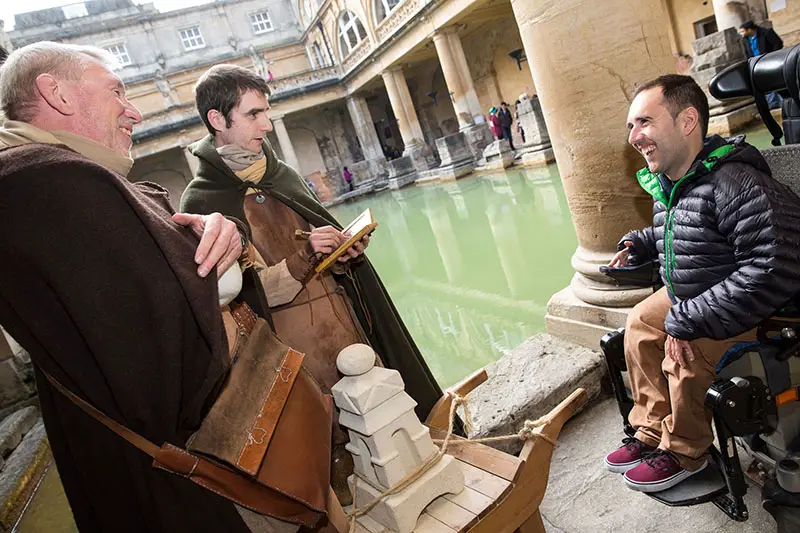
Roman Baths and Pump Room: accessible history in action
Recently Disability Horizons co-editor Martyn Sibley took a trip to the historic Roman Baths in Bath to find out how accessible they really are. Find out how he got on. . .
Bath is a city renowned for its ancient Roman heritage, the Romans settled in bath in AD60. The Romans developed the city as a centre of recreation and built around the natural hot springs and named the city Aquae Sulis meaning ‘the waters of Sulis’. Sulis Minerva was the British-Roman goddess worshipped at the thermal spring of Bath. The clever Romans built a clever lead pipe system allowing 1.3million litres of naturally-heated water to be pumped to the surface daily. They also built the spa and a nearby temple to worship the goddess Minerva. This was the first leisure centre of its kind and Roman people came from far and wide to bath in the waters and worship at the temple. Following in their footsteps, I was excited to see what the spa had to offer me.
Roman architecture and building might not be renowned for its accessibility, but with the addition of two DDA-compliant lifts and a number of other sensitive measures, the site is now over 90% accessible. This meant that I really got to explore the hidden depths of the site, and the amazing history behind them.
The baths themselves are built 6 metres below current street level, but my venture into the Roman history of Bath started at street level at the Terrace. The Terrace overlooks the Great Bath, which represents under a quarter of the site as a whole so there is a whole lot more to explore. But take care, Roman paving is pretty uneven, thankfully the stone railing on the Terrace, raised stones around the Great Bath and helpfully-placed handrails mean you can’t fall overboard!

I took a ride in the new lift to explore the treasures that are hidden below street level. There are some amazing historic collections discovered over the years on display including a collection of over 17,000 Roman coins and the Roman curses. The coins were collected because the Romans used to throw them into the sacred water as an offering to the Goddess Minerva, and the curses are messages and prayers inscribed on small lead sheets to Minerva.
Martin trys out the accessibility of the Roman Baths museum. March 2015. Photographer Freia Turland e:info@ftphotography.co.uk m:07875514528
Throughout the site you’ll stumble across costumed characters who help to tell the story of the Roman Baths. They are based on real people who lived and worked at Aquae Sulis in the Roman times and you can find more information about some of them in the museum. I met Sulinus and Brucetus, stonemasons from the Roman era. These characters really made the visit for me, they brought the story to life and made all of the information feel much more real.

You can’t leave without visiting the majestic Pump Room, it was the place to be seen in the 18th century in Bath. Now with street level access, it’s a treat not to be missed and serves a delicious afternoon tea. And don’t miss out on a glass of the famous spa water that flows from an ornate fountain in the Pump Room; thought to be a treatment for certain conditions in the 17th century it contains over 43 minerals.
The Roman Baths have done so much to enable disabled visitors to explore this fascinating site and to have a memorable experience. Disabled visitors pay the normal admission price but an accompanying carer is allowed in for free. Each visitor is given an audioguide to help guide them around the exhibitions, a video BSL guide is available free of charge on request or you can request an audioguide compatible with the ‘T’ switch on a hearing aid. For the visually impaired, there are braille guides and tactile displays throughout the exhibition, and braille transcripts of the audioguide. With some notice it is also possible to arrange for a guided tour from a signing guide, call in advance to arrange (01225 477785). Two wheelchairs and a mobility scooter are available for visitors but can’t be booked in advance. And there are accessible toilets available at the entrance.
I’m always a little apprehensive with accessibility in historic buildings, particularly when they’re listed like the Roman Baths. I was expecting some accessibility features to be missing, but overall I was really impressed with the reality and how easily I could explore this fascinating site. The features all seemed to fit seamlessly into the historical surroundings, they are very sensitively designed. The Roman Baths is definitely a place to add to your travel list!
If you want to find out more about The Roman Baths and its accessibility you can check it out at www.romanbaths.co.uk/accessibility
If you fancy a dip in the sacred waters, head down the road to the new Thermae Bath Spa, 100 metres from the Roman Baths. Here you can swim in the hot water and relax in a number of different settings. Parking for registered disabled people is available on Bath Street, but be sure to display your clock as it is time-limited. There are lots of accessible features in the twenty-first century spa facilities; the open-air rooftop pool and Cross Bath outdoor pool both have assisted access chairs and accessible changing facilities and toilets. Unfortunately I didn’t have time on my visit but it looked so inviting!
By Martyn Sibley
Get in touch by messaging us on Facebook, tweeting us @DHorizons, emailing us at editor@disabilityhorizons.com or leaving your comments below.
If you’re planning your next holiday, why not visit our new travel site, Accomable, to find accessible accommodation not just in the UK, but across the world.